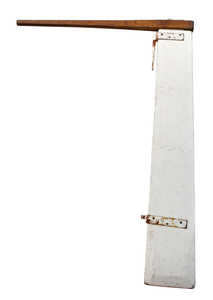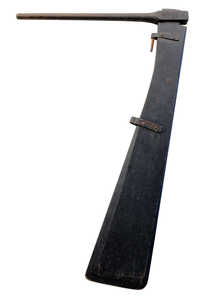Types of boat
If we analyse the various documentary sources, we can see
that the outline and rig of smaller Basque vessels is generally
the same in any given period; the only difference is in the
size and, to some extent, the proportions.
The type of fishing technique used determined the size of
the boats, which were distinguished from one another by the
number of thwarts.
The space between thwarts was always the same. For example
a tuna boat, kalerua, had ten or eleven thwarts; a fishing
smacks had eight or nine; a sardine boat or potina had six
or seven; and the smallest boat, the batel, had just four. The
space between thwarts was always the same. For example a
tuna boat, kalerua, had ten or eleven thwarts; a fishing
smacks had eight or nine; a sardine boat or potina had six
or seven; and the smallest boat, the batel, had just four.
Broadly speaking, this distinction has remained over the
centuries, giving four groups of boat of different sizes, each
used for specific activities.
Oars. Smaller Basque vessels have all been designed to be
rowed. They are generally intended to fit as many oarsmen as possible.
The oars were generally made of beech wood, and occasionally
ash.

© José Lopez

© José Lopez

© José Lopez
Rudders. The rudder on the smaller Basque vessels is generally
removable, and is used only when the boat is travelling under
sail. As well as being used to steer the vessel, the rudder also acts
as a fin, making up for the lack of a deep keel to prevent sideways
drift; it is for this reason that the rudder extends down below the
draft of the vessel.

© José Lopez

© José Lopez

© José Lopez
Centreboards. Sailing close to the wind, the rudder may not
provide sufficient lateral face to prevent drifting. In these vessels,
with a very shallow draft, a removable side keel was secured to the
outside of the vessel to leeward to reduce sideways drift.

© José Lopez

© José Lopez

Trainera. The trainera escapes any traditional classification of
Basque fishing vessels. It measured around twelve metres in length
and generally had nine thwarts. It differed in its proportions and
profile to other boats. It was originally designed for fishing for sardines
using encircling nets, which required a faster and more
manoeuvrable vessel than the traditional sardine boat. Its success
led to the development of the fish-preserving industry along this
coast. © José Lopez

Model of a lug-rigged tuna boat, with watertight decks. © José Lopez

Sardine boat or potina . Around eight metres in length with
six to seven thwarts. It was used for fishing for sardine close to the
coast with gillnets. Like other types of small boat, sardine boats
would sometimes engage in other types of fishing outside their
usual speciality. © José Lopez

Kalerua (Fishing smack). Around ten metres in length with
eight to nine thwarts. Because of its size, it was ideal for travelling
safely to fishing grounds on the edge of the continental shelf, several
miles from the coast. Depending on the seasons, they might
also fish for hake, bream and occasionally tuna. Kaleruak were also
used for towing larger ships. © José Lopez

Tuna boat or txalupa. About thirteen metres in length with ten
to eleven thwarts. These boats were mainly used for fishing tuna
during the summer months, travelling around the Bay of Biscay
under sail in search of the great shoals of bonito. They often travelled
a long distance from the coast, spending several days at sea
with no conveniences of any sort. They also frequented the ports of
Asturias and Cantabria, where they would sell their catch. © José Lopez

Batel. Around five metres in length with four thwarts, this
small vessel was used for inshore fishing in estuaries and bays. It
was also used to ferry passengers across rivers. © José Lopez


















